同济大学:《传播信道特征估计和建模》课程教案讲义(射线追踪)02 Geometrical Theory of Propagation I - The ray concept – Reflection and transmission
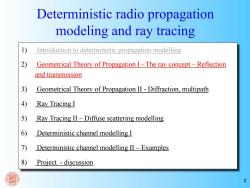
Deterministic radio propagation modeling and ray tracing 1 Introduction to deterministic propagation modelling 2) Geometrical Theory of Propagation I-The ray concept-Reflection and transmission 3) Geometrical Theory of Propagation II-Diffraction,multipath 4) Ray Tracing I 5) Ray Tracing II-Diffuse scattering modelling 6) Deterministic channel modelling I 7) Deterministic channel modelling II-Examples 8) Project -discussion
1 Deterministic radio propagation modeling and ray tracing 1) Introduction to deterministic propagation modelling 2) Geometrical Theory of Propagation I - The ray concept – Reflection and transmission 3) Geometrical Theory of Propagation II - Diffraction, multipath 4) Ray Tracing I 5) Ray Tracing II – Diffuse scattering modelling 6) Deterministic channel modelling I 7) Deterministic channel modelling II – Examples 8) Project - discussion
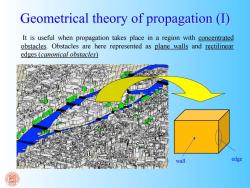
Geometrical theory of propagation(D) It is useful when propagation takes place in a region with concentrated obstacles.Obstacles are here represented as plane walls and rectilinear edges (canonical obstacles) wall edge
Geometrical theory of propagation (I) It is useful when propagation takes place in a region with concentrated obstacles. Obstacles are here represented as plane walls and rectilinear edges (canonical obstacles) wall edge
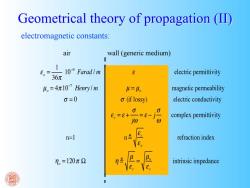
Geometrical theory of propagation(ID) electromagnetic constants: air wall(generic medium) 1 e,36m 10 Farad/m electric permittivity 4。=4π10Heny/m l=。 magnetic permeability 0=0 o (if lossy) electric conductivity e.=e+ 三 complex permittivity j0 n=1 n 。 refraction index 1。=120π2 intrinsic impedance
Geometrical theory of propagation (II) electromagnetic constants: air wall (generic medium) ε o = 1 36π 10−9 Farad / m ε electric permittivity µo = 4π 10−7 Henry / m µ = µo magnetic permeability σ = 0 σ (if lossy) electric conductivity ε c = ε + σ jω = ε − j σ ω complex permittivity n=1 n ε c ε o refraction index ηo = 120π Ω η µ ε c = µo ε c intrinsic impedance
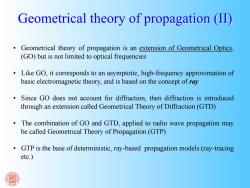
Geometrical theory of propagation (ID) Geometrical theory of propagation is an extension of Geometrical Optics, (GO)but is not limited to optical frequencies Like GO,it corresponds to an asymptotic,high-frequency approximation of basic electromagnetic theory,and is based on the concept of ray Since GO does not account for diffraction,then diffraction is introduced through an extension called Geometrical Theory of Diffraction(GTD) The combination of GO and GTD,applied to radio wave propagation may be called Geometrical Theory of Propagation(GTP) GTP is the base of deterministic,ray-based propagation models(ray-tracing etc.)
Geometrical theory of propagation (II) • Geometrical theory of propagation is an extension of Geometrical Optics, (GO) but is not limited to optical frequencies • Like GO, it corresponds to an asymptotic, high-frequency approximation of basic electromagnetic theory, and is based on the concept of ray • Since GO does not account for diffraction, then diffraction is introduced through an extension called Geometrical Theory of Diffraction (GTD) • The combination of GO and GTD, applied to radio wave propagation may be called Geometrical Theory of Propagation (GTP) • GTP is the base of deterministic, ray-based propagation models (ray-tracing etc.)
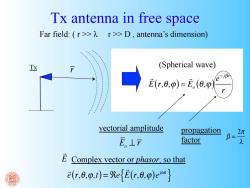
Tx antenna in free space Far field:(r>>r>>D,antenna's dimension) (Spherical wave) r.0.p)=E(0p7 vectorial amplitude propagation B= 2元 E。⊥T factor E Complex vector or phasor,so that e(r.0.p.t)-RefE(r.0.p)e]
Tx antenna in free space ? Far field: ( r >> λ r >> D , antenna’s dimension) Tx (Spherical wave) E(r,θ,ϕ) ≈ Eo (θ,ϕ) e− jβr r vectorial amplitude e (r,θ,ϕ,t) = ℜe E(r,θ,ϕ)ejωt { } E Complex vector or phasor, so that propagation factor β = 2π E λ o ⊥ r r
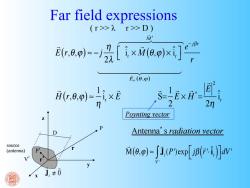
Far field expressions (r>λr>D)》 头 ao-员[xapk町 E(6,p) .dp)-ix x 2 2n Poynting vector Antenna's radiation vector source (antenna) P' Mme.p)=j.Pep[i小aW 上 j,≠0
E(r,θ,ϕ) ≈ − j η 2λ ˆ i r × M (θ,ϕ) × ˆ i r ⎡ ⎣ ⎤ ⎦ e− jβr r H (r,θ,ϕ) ≈ 1 η ˆ i r × E S= 1 2 E × H* = E 2 2η ˆ i r M(θ,ϕ) ≈ Ji(P') V ' ∫ exp jβ r '⋅ˆ i ( r ) ⎡ ⎣ ⎤ ⎦dV ' Far field expressions ( r >> λ r >> D ) Antenna’ s radiation vector V’ P’ P r ’ r y x z D Eo (θ,ϕ) Ji ≠ 0 M t source (antenna) Poynting vector
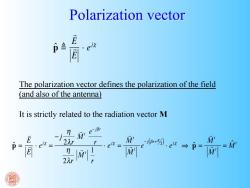
Polarization vector p The polarization vector defines the polarization of the field (and also of the antenna) It is strictly related to the radiation vector M 二J2沟 =e明.e以= 一=M 22r
p ˆ E E ⋅ ejχ Polarization vector The polarization vector defines the polarization of the field (and also of the antenna) It is strictly related to the radiation vector M p ˆ = E E ⋅ ejχ = − j η 2λr M t e− jβr r η 2λr M t 1 r ⋅ ejχ = M t M t e − j βr+π 2 ( ) ⋅ ejχ ⇒ p ˆ = M t M t = M ˆ t
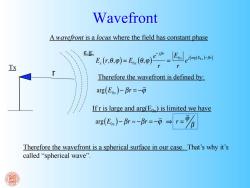
Wavefront A wavefront is a locus where the field has constant phase e.g: E.0.)-F.(. Therefore the wavefront is defined by: arg(Eos)-Br=- If r is large and arg(E)is limited we have arg(Er)-Br≈-Br=-p→r= Therefore the wavefront is a spherical surface in our case.That's why it's called"spherical wave
Wavefront r Tx Ex (r,θ,ϕ) = E0 x (θ,ϕ) e− jβr r = E0 x r ej(arg(E0 x )−βr) A wavefront is a locus where the field has constant phase Therefore the wavefront is defined by: arg(E0 x ) − βr = −ϕ If r is large and arg(E0x) is limited we have arg(E0 x ) − βr ≈ −βr = −ϕ ⇒ r = ϕ β Therefore the wavefront is a spherical surface in our case. That’s why it’s called “spherical wave”. e.g:
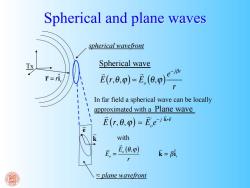
Spherical and plane waves spherical wavefront Spherical wave 下=ri (.6,p)=E。(0,p), In far field a spherical wave can be locally approximated with a Plane wave E(,0,p)≈E,e with E E(6,9 k=Bi, ≈plane wavefront
Spherical and plane waves Tx spherical wavefront Spherical wave E(r,θ,ϕ) ≈ Eo (θ,ϕ) e− jβr r r = rˆ ir with Eo ' = Eo (θ,ϕ) r k = βˆ ir In far field a spherical wave can be locally approximated with a Plane wave E (r,θ,ϕ) ≈ Eo ' e− j ki r ≈ plane wavefront k e

Definition of Ray (1/2) Given a propagating wave,every curve that is everywhere perpendicular to the wavefront is called electromagnetic ray.A ray is the path of the wavefront.There is a mutual identification btw wave and ray Therefore we assume that the ray also has a field,the field of the wave at every point
Definition of Ray (1/2) • Given a propagating wave, every curve that is everywhere perpendicular to the wavefront is called electromagnetic ray. A ray is the path of the wavefront. There is a mutual identification btw wave and ray • Therefore we assume that the ray also has a field, the field of the wave at every point
按次数下载不扣除下载券;
注册用户24小时内重复下载只扣除一次;
顺序:VIP每日次数-->可用次数-->下载券;
- 同济大学:《传播信道特征估计和建模》课程教案讲义(射线追踪)01 Deterministic radio propagation modeling and ray tracing - Introduction to deterministic propagation modelling.pdf
- 同济大学:《传播信道特征估计和建模》课程教学资源(课件讲稿)Chapter 3 Generic channel models.pdf
- 同济大学:《传播信道特征估计和建模》课程教学资源(课件讲稿)Chapter 2 Characterization of Propagation Channels.pdf
- 同济大学:《传播信道特征估计和建模》课程教学资源(课件讲稿)Chapter 1 Introduction - History of Channel Characterization and Modeling.pdf
- 同济大学:《传播信道特征估计和建模》课程教学资源(教案讲义)Chapter 09 Practices - channel modeling for modern communication systems.pdf
- 同济大学:《传播信道特征估计和建模》课程教学资源(教案讲义)Chapter 08 Measurement based statistical channel modeling.pdf
- 同济大学:《传播信道特征估计和建模》课程教学资源(教案讲义)Chapter 07 Statistical channel parameter estimation.pdf
- 同济大学:《传播信道特征估计和建模》课程教学资源(教案讲义)Chapter 06 Deterministic channel parameter estimation.pdf
- 同济大学:《传播信道特征估计和建模》课程教学资源(教案讲义)Chapter 05 Channel measurements.pdf
- 同济大学:《传播信道特征估计和建模》课程教学资源(教案讲义)Chapter 04 Geometry based stochastic channel modeling.pdf
- 同济大学:《传播信道特征估计和建模》课程教学资源(教案讲义)Chapter 03 Generic channel models.pdf
- 同济大学:《传播信道特征估计和建模》课程教学资源(教案讲义)Chapter 02 Characterization of Propagation Channels.pdf
- 同济大学:《传播信道特征估计和建模》课程教学资源(教案讲义)Chapter 01 Introduction.pdf
- 同济大学:《传播信道特征估计和建模》课程教学资源(教案讲义)Propagation Channel Characterization, Parameter Estimation, and Modeling for Wireless Communications - Preface.pdf
- 长沙理工大学:《现代电信交换》课程PPT教学课件(程控交换)第6章 ATM交换与B-ISDN(异步传送模式——宽带综合业务数字网).ppt
- 长沙理工大学:《现代电信交换》课程PPT教学课件(程控交换)第5章 分组交换与分组交换网.ppt
- 长沙理工大学:《现代电信交换》课程PPT教学课件(程控交换)第4章 信令系统.ppt
- 长沙理工大学:《现代电信交换》课程PPT教学课件(程控交换)第3章 电路交换与电话通信网.ppt
- 长沙理工大学:《现代电信交换》课程PPT教学课件(程控交换)第2章 交换网络.ppt
- 长沙理工大学:《现代电信交换》课程PPT教学课件(程控交换)第1章 交换概论(负责人:龙敏,主讲:蔡春娥).ppt
- 同济大学:《传播信道特征估计和建模》课程教案讲义(射线追踪)03 Geometrical Theory of Propagation II - Diffraction, multipath.pdf
- 同济大学:《传播信道特征估计和建模》课程教案讲义(射线追踪)04 Ray Tracing I - Deterministic ray models.pdf
- 同济大学:《传播信道特征估计和建模》课程教案讲义(射线追踪)05 Ray Tracing II – Diffuse scattering modelling.pdf
- 同济大学:《传播信道特征估计和建模》课程教案讲义(射线追踪)06 Deterministic channel modelling I(static channel case).pdf
- 同济大学:《传播信道特征估计和建模》课程教案讲义(射线追踪)07 Deterministic channel modelling II – Examples.pdf
- 数字电子技术基础学习方法.doc
- 模拟电子技术学习方法.doc
- 电子技术基础学习方法探索.pdf
- 山东第一医科大学:《医学影像电子学》课程教学资源(试卷习题)医学影像电子学模式试题及参考答案(一).doc
- 山东第一医科大学:《医学影像电子学》课程教学资源(试卷习题)医学影像电子学模式试题及参考答案(二).doc
- 山东第一医科大学:《医学影像电子学》课程教学资源(试卷习题)医学影像电子学模式试题及参考答案(三).doc
- 山东第一医科大学:《医学影像电子学》课程教学资源(试卷习题)医学影像电子学模式试题及参考答案(四).doc
- 山东第一医科大学:《医学影像电子学》课程教学资源(试卷习题)医学影像电子学模式试题及参考答案(五).doc
- 山东第一医科大学:《医学影像电子学》课程教学资源(试卷习题)医学影像电子学模式试题及参考答案(六).doc
- 山东第一医科大学:《医学影像电子学》课程教学资源(试卷习题)医学影像电子学模式试题及参考答案(七).doc
- 山东第一医科大学:《医学影像电子学》课程教学资源(试卷习题)医学影像电子学模式试题及参考答案(八).doc
- 山东第一医科大学:《医学影像电子学》课程教学资源(试卷习题)医学影像电子学模式试题及参考答案(九).doc
- 山东第一医科大学:《医学影像电子学》课程教学资源(试卷习题)医学影像电子学模式试题及参考答案(十).doc
- 山东第一医科大学:《医学影像电子学》课程教学资源(试卷习题)医学影像电子学习题与答案(一)常用半导体器件.doc
- 山东第一医科大学:《医学影像电子学》课程教学资源(试卷习题)医学影像电子学习题与答案(七)信号的运算和处理.doc
